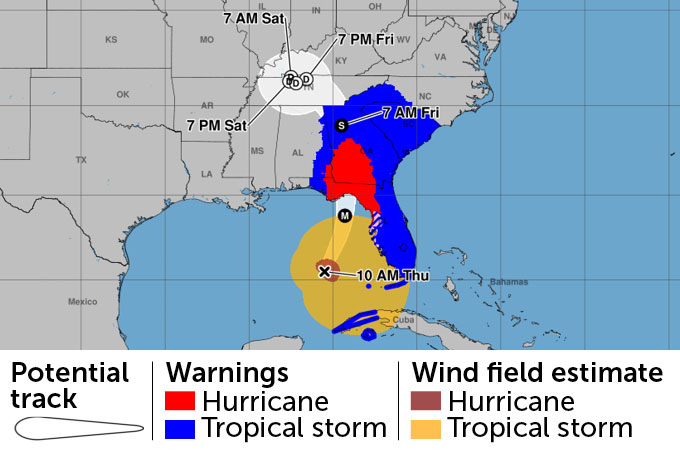Extreme Climate Survey
Scientific news is collecting readers’ questions about how to navigate our planet’s changing climate.
What do you want to know about extreme heat and how it can lead to extreme weather events?
In just 60 hours, the NHC predicted that PTC9 would intensify at a record pace, going from winds of less than 35 knots (about 65 kilometers per hour) to hurricane-force winds of at least 100 knots (185 kilometers per hour).
It was the fastest predicted transition from concern to major hurricane in NHC history.
And these predictions were right. Driven by the deep, super-heated waters of the Gulf of Mexico and unhindered by any shearing winds that could stutter the storm’s growth, Helene began to surge.
Here are three things to keep in mind as Helene continues to barrel into the southeastern United States.
Rapid intensification is becoming the new normal for hurricanes.
The NHC defines rapid intensification as when a storm’s maximum sustained winds jump by at least 56 km/h (35 mph) in less than a day (SN: 9/13/23).
Against the background of persistent temperatures, record tropical water, numerous storms in recent years have met and even exceeded this definition (SN: 15.6.23). In 2023, for example, Atlantic hurricanes Idalia and Lee increased their intensity by about 58 km/h within 24 hours.
Helena isn’t just a textbook case of so-rapid intensification—she’s the star student.
Scientists have been gnashing their teeth, predicting just such an event, given the super-hot waters of 2024. Helena’s fury was fueled by record hot temperatures in the Gulf of Mexico. Sea surface temperatures in the Gulf are high, in some places 2 degrees Celsius higher than the September average of around 29°C. But even more importantly, the excess heat of the Gulf’s ocean isn’t just deep: the waters stay very warm. deep in the water column, increasing the overall heat content of the ocean and providing even more fuel for a rotating storm (SN: 7/2/24).
Another favorable factor for hurricane formation in the Gulf was the absence of wind shear, changes in wind direction or higher speed in the atmosphere. Faster upper-atmosphere winds can eat into a tightly rotating cyclone, removing the heat and moisture they need from their centers.
Smaller cyclones may be even more prone to rapid intensification.
Even as Helene took center stage, forecasters were reeling from the sudden intensification of another tropical cyclone, Hurricane John, which bore down on Mexico’s southern Pacific coast on September 23.
That was two full days earlier than researchers had predicted.
Also fueled by warm ocean waters, the storm had strengthened into a Category 3 storm just hours after being classified as a tropical storm. This dramatic, sudden increase in power and speed caught both scientists and officials off guard as they scrambled to sound the alarm before it hit the ground.

As Helena and John show, both large and small storms can be subject to rapid intensification. But recent research suggests there may be a reason why forecasters were caught off guard by John’s sudden rise. And that may have something to do with the size of the storm.
A 2014 analysis of tropical cyclone size and intensification from 1990 to 2010 suggested that smaller, compact storms like John — only a fraction of Helena’s width — may be particularly prone to intensification so suddenly that they can confound predictions.
In particular, how big the inner core—the eye of the hurricane—is at first may come into play. This may be because storms with larger inner cores may be more resistant to structural changes by external forces. Such forces may include heat transfer from ocean waters.
New projections of inland impacts show how intensification is not just a coastal problem.
In August, the NHC debuted an experimental hurricane forecast cone that includes not only a storm’s projected path toward land, but also regions where its powerful winds can be felt far inland. The purpose of this new type of projection, the center said in February, is to raise public awareness of storm hazards that may exist far from the eye of the storm, or long after landfall (SN: 29.2.24).
That’s especially important for Hurricane Helene, which was forecast to bring catastrophic storm surges of up to six feet as it made landfall in Florida’s Big Bend region — one of the largest surge forecasts the center has ever made. This is equivalent to a two-story high wall of water jutting out onto the shore.
Helena also had a large field of tropical storm-force winds that could extend as much as 500 kilometers from the storm’s center — essentially covering the entire state. It is estimated to end up as one of the five largest Gulf of Mexico storms on record in terms of the size of that wind field.
The experimental forecast suggested that Helene’s dangers would extend across the southeastern United States. Hours after landfall on September 27, Helene was downgraded to a tropical storm as it continued to barrel northward, bringing strong winds and power outages, as well as torrential rain and flash flooding across Georgia. South Carolina and North Carolina.
#rapid #intensification #produced #monster #hurricanes #week
Image Source : www.sciencenews.org